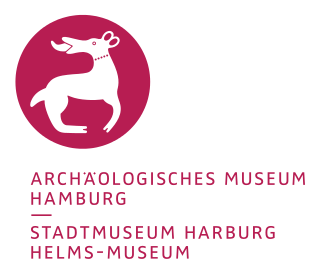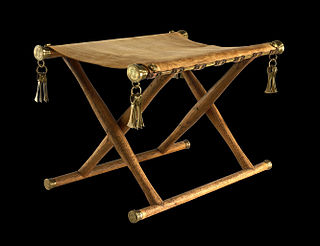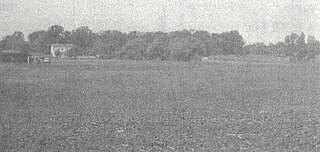
Sutton Hoo is the site of two Anglo-Saxon cemeteries dating from the 6th to 7th centuries near Woodbridge, Suffolk, England. Archaeologists have been excavating the area since 1938, when an undisturbed ship burial containing a wealth of Anglo-Saxon artifacts was discovered. The site is important in establishing the history of the Anglo-Saxon kingdom of East Anglia as well as illuminating the Anglo-Saxons during a period which lacks historical documentation.

A plank road is a road composed of wooden planks or puncheon logs, as an efficient technology for traversing soft, marshy, or otherwise difficult ground. Plank roads were commonly found in the Canadian province of Ontario as well as the Northeast and Midwest of the United States in the first half of the 19th century. They were often built by turnpike companies.
The Arras culture is an archaeological culture of the Middle Iron Age in East Yorkshire, England. It takes its name from the cemetery site of Arras, at Arras Farm, (53.86°N 0.59°W) near Market Weighton, which was discovered in the 19th century. The site spans three fields, bisected by the main east-west road between Market Weighton and Beverley, and is arable farmland; little to no remains are visible above ground. The extent of the Arras culture is loosely associated with the Parisi tribe of pre-Roman Britain.

La Chapelle-aux-Saints is a commune in the Corrèze department in central France.

The Archäologisches Museum Hamburg is an archaeological museum in the Harburg borough of Hamburg, Germany. It houses the archaeological finds of the city of Hamburg and the neighbouring counties to the south of the city. It focuses on northern German prehistory and early history as well as the history of the former city of Harburg. The museum is also home to the cultural heritage landmarks commission of the city of Hamburg and the adjacent district of Harburg in Lower-Saxony and thus supervises all archaeological undertakings in the region.
Joachim Werner was a German archaeologist who was especially concerned with the archaeology of the Early Middle Ages in Germany. The majority of German professorships with particular focus on the field of the Early Middle Ages were in the second half of the 20th century occupied by his academic pupils.

Horse burial is the practice of burying a horse as part of the ritual of human burial, and is found among many Indo-European speaking peoples and others, including Chinese and Turkic peoples. The act indicates the high value placed on horses in the particular cultures and provides evidence of the migration of peoples with a horse culture. Human burials that contain other livestock are rare; in Britain, for example, 31 horse burials have been discovered but only one cow burial, unique in Europe. This process of horse burial is part of a wider tradition of horse sacrifice. An associated ritual is that of chariot burial, in which an entire chariot, with or without a horse, is buried with a dead person.

The Wittmoor bog trackway is the name given to each of two historic corduroy roads, trackway No. I being discovered in 1898 and trackway No. II in 1904 in the Wittmoor bog in northern Hamburg, Germany. The trackways date to the 4th and 7th century AD, both linked the eastern and western shores of the formerly inaccessible, swampy bog. A part of the older trackway No. II dating to the period of the Roman Empire is on display at the permanent exhibition of the Archaeological Museum Hamburg in Harburg, Hamburg.

The Duvensee paddles is the preserved part of a Mesolithic spade paddle, which was found during archaeological excavations of a Mesolithic dwelling area at Duvensee near Klinkrade Schleswig-Holstein, Germany in 1926. After a paddle from Star Carr in England, the Duvensee paddle is the second oldest known paddle and is considered among the earliest evidence for the use of water transport in the Mesolithic. The find is in the permanent exhibition of the Archaeological Museum Hamburg in Harburg, Hamburg.

The Daensen folding chair consists of the metallic remains of a folding chair which were discovered in 1899 in sand from a Bronze Age tumulus near Daensen, a part of Buxtehude, Lower Saxony, Germany. The chair is the southernmost and most richly decorated example of the eighteen known folding chairs of the Nordic Bronze Age in Northern Europe. The fittings, along with a reconstruction, are in the permanent exhibition of the Archaeological Museum Hamburg in Harburg, Hamburg.

The Tangendorf disc brooch is an Iron Age fibula from the 3rd century AD, which was dug up in 1930 from the sand of a Bronze Age tumulus near Tangendorf, Toppenstedt, Harburg, Lower Saxony, Germany. The front of the elaborately crafted garment fibula is decorated with a rear-facing four-legged animal, probably a dog or a deer. It is one of Harburg's most important finds from the period of the Roman Empire, and is in the permanent exhibition of the Archaeological Museum Hamburg in Harburg, Hamburg.

The Ovelgönne bread roll is the remaining part of a bread roll originating from the Pre-Roman Iron Age of Northern Europe, which was found in 1952 during archaeological excavations in a loam mine in the Buxtehude district Ovelgönne in Lower Saxony, Germany. The piece of bread is the oldest surviving formed bakery product from Europe. The find, along with a reconstruction, are in the permanent exhibition of the Archaeological Museum Hamburg in Harburg, Hamburg.

The Metzendorf-Woxdorf head of burial is the Neolithic burial of a single human skull that was found in 1958 in the Seevetal district of Woxdorf, in Harburg, in Lower Saxony. The find is currently the only one of its kind of the Single Grave Culture in Germany and is in the permanent exhibition of the Archaeological Museum Hamburg in Harburg, Hamburg.

The Maschen disc brooch is an Early Medieval fibula, which was found in 1958 during archaeological excavations of the late Saxon grave field near Maschen, in the Lower Saxony district of Harburg, Germany. On its face side, the fibula shows an unidentified saint with a halo. It was found in a woman's grave of the beginning of the Christianization of northern Germany, and is in the permanent exhibition of the Archaeological Museum Hamburg in Harburg, Hamburg.

The secondary burial, or “double funeral” is a feature of prehistoric and historic gravesites. The term refers to remains that represent an exhumation and reburial, whether intentional or accidental.

The Scythian culture was an Iron Age archaeological culture which flourished on the Pontic-Caspian steppe in Eastern Europe from about 700 BC to 200 AD. It is associated with the Scythians, Cimmerians, and other peoples inhabiting the region of Scythia, and was part of the wider Scytho-Siberian world.

The Knoll Spring site (11Ck-19), aka Au Sagaunashke village, is located in the Sag Valley, Palos Hills, in Cook County, Illinois, near the city of Chicago. It is classified as a late prehistoric site with Upper Mississippian Huber affiliation.
The Anker Site (11Ck-21) is located on the Little Calumet River near Chicago, Illinois. It is classified as a late prehistoric site with Upper Mississippian Huber affiliation.
The Gentleman Farm site is an archaeological site located in LaSalle County, Illinois, on the Illinois River. It is a multi-component site with the main occupation being a Langford tradition component of Upper Mississippian affiliation.
Eduard Voss was a German entomologist, who specialized in beetles (Coleoptera), in particular the weevil family (Curculionidae). He described many new species and a number of beetles are named after him. Much of his beetle collection was lost in World War II, but some of the remaining collection is held in the Zoologischs Museum Hamburg.


















